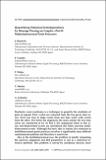Quantifying statistical interdependence by message passing on graphs—Part II: Multidimensional point processes
Author(s)
Dauwels, Justin H. G.; Vialatte, F.; Weber, Theophane G.; Cichocki, Andrzej
DownloadDauwels-2009-Quantifying Statistical Interdependence by Message Passing on Graphs-Part II.pdf (2.889Mb)
PUBLISHER_POLICY
Publisher Policy
Article is made available in accordance with the publisher's policy and may be subject to US copyright law. Please refer to the publisher's site for terms of use.
Terms of use
Metadata
Show full item recordAbstract
Stochastic event synchrony is a technique to quantify the similarity of pairs of signals. First, events are extracted from the two given time series. Next, one tries to align events from one time series with events from the other. The better the alignment, the more similar the two time series are considered to be. In Part I, the companion letter in this issue, one-dimensional events are considered; this letter concerns multidimensional events. Although the basic idea is similar, the extension to multidimensional point processes involves a significantly more difficult combinatorial problem and therefore is nontrivial. Also in the multidimensional case, the problem of jointly computing the pairwise alignment and SES parameters is cast as a statistical inference problem. This problem is solved by coordinate descent, more specifically, by alternating the following two steps: (1) estimate the SES parameters from a given pairwise alignment; (2) with the resulting estimates, refine the pairwise alignment. The SES parameters are computed by maximum a posteriori (MAP) estimation (step 1), in analogy to the one-dimensional case. The pairwise alignment (step 2) can no longer be obtained through dynamic programming, since the state space becomes too large. Instead it is determined by applying the max-product algorithm on a cyclic graphical model. In order to test the robustness and reliability of the SES method, it is first applied to surrogate data. Next, it is applied to detect anomalies in EEG synchrony of mild cognitive impairment (MCI) patients. Numerical results suggest that SES is significantly more sensitive to perturbations in EEG synchrony than a large variety of classical synchrony measures.
Date issued
2009-08Department
Massachusetts Institute of Technology. Laboratory for Information and Decision Systems; Massachusetts Institute of Technology. Operations Research CenterJournal
Neural Computation
Publisher
MIT Press
Citation
Dauwels, J. et al. “Quantifying Statistical Interdependence by Message Passing on Graphs—Part I: One-Dimensional Point Processes.” Neural Computation 21.8 (2009): 2152-2202. ©2009 Massachusetts Institute of Technology
Version: Final published version
ISSN
0899-7667